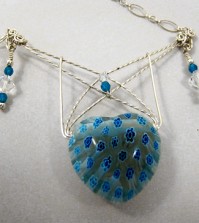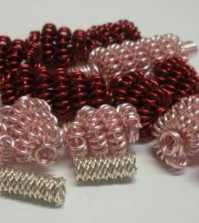- NEW DVD Series – Stone Setting with Bezels
- Tube Set Charm by Kim St. Jean
- Prong Basket Pendant by Kim St. Jean
- NEW DVD Series – Stone Setting with Cold Connections
- New DVD Series – Stone Setting with Wire
- NEW DVD Series: Introduction to Stone Setting by Kim St. Jean
- Featured Tool: Bracelet Bending Plier
- NEW Dvd by Eva Sherman
- Fun, Fast Fold Forming DVD Series
- Double Band Ear Cuff from Alex Simkin
American Wire Gauge
How is wire gauged? Since 1857, the United States has been using a standard system in measuring the diameter of wire. This system is known as American Wire Gauge (AWG), or the Brown & Sharp (B&S) gauge, and was invented by J.R. Brown. A customary wire gauge is circular or rectangular in shape with grooves along the outside. The size of the grooves represents the diameter of the wire. The higher the gauge number, the smaller the diameter and finer the wire. The lower the gauge number, the bigger the diameter and thicker the wire. When wire is manufactured, thick wire is progressively stretched to thinner and thinner wire, until the desired gauge is achieved. This process is recognized as wire drawing or die casting. The wire is pulled through one or more drawing dies (a metal mold consisting of larger to smaller holes) to acquire a number gauge. The wire gauge measurement refers to the number of dies that the wire had to be pulled through to achieve the specific diameter. In other words, higher gauge wires are pulled through more dies than the lower gauge wires.
AWG measurements can be found from a 000000 gauge, which is ¬about a half an inch in diameter, down to a 40 gauge, which is equivalent to 0.00314 inches or .07986 millimeters in diameter. Typical telephone wire is 22, 24, or 26 gauge, household wiring is 12 or 14, and electronic wiring is commonly a 20 gauge. In the AWG system, when the measurement of the gauge decreases by six, the diameter of the wire doubles. For instance, a 24 gauge wire is about .02” in diameter, an 18 gauge wire is about .04” in diameter, and a 12 gauge wire is about .08” in diameter.
Note: Great Britain and Canada do not use the AWG; they use what is known as the Imperial or British Standard Wire Gauge (SWG or BSG). Under the SWG system, the thickest wire is 7/0 gauge, which is about 12.7mm and the thinnest is 50 gauge, which is equivalent to 25 µm. Just to give an example of the difference between AWG and SWG, wire gauged at 1 in AWG has a diameter of 0.28997 inches; in SWG its diameter is 0.3 inches.”
























0 comments